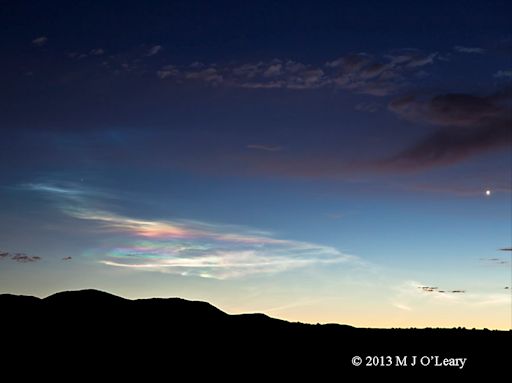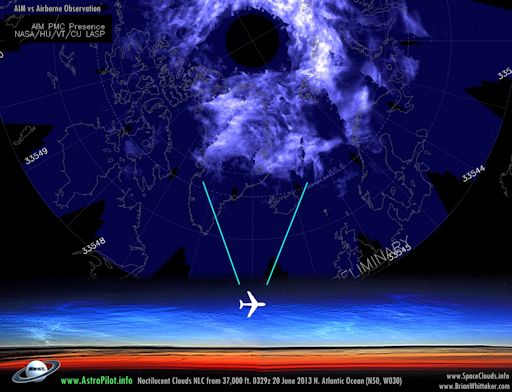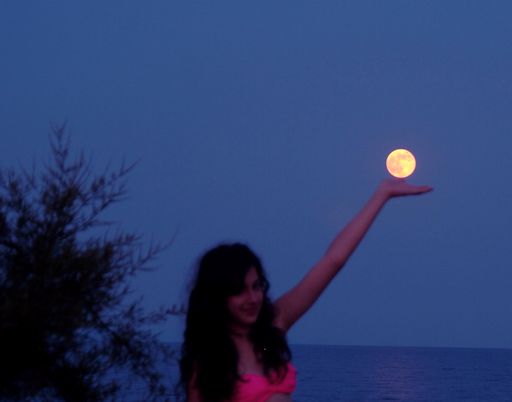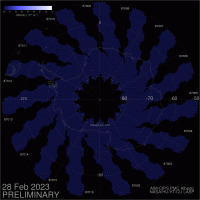EARTH-DIRECTED FLARES: Southern hemisphere sunspots AR1777 and AR1778 erupted in quick succession during the early hours of June 28th, producing a pair of C-class solar flares and at least one CME. An initial analysis of coronagraph images suggests that the CME could deliver a glancing blow to Earth's magnetic field over the weekend. Stay tuned for updates. SWx alerts: text, voice.
SOLAR OBSERVATORY LAUNCHED: NASA's newest space telescope, a unique solar observatory named "IRIS", is orbiting Earth today following a successful launch on June 27th at 7:27 pm PDT. Leaving from the Vandenberg Air Force Base in California, an Orbital L-1011 aircraft carried IRIS inside a Pegasus XL rocket out over the Pacific Ocean, where the rocket separated from the belly of the airplane and blasted into space. The rocket's exhaust created a beautiful sunset display along the central California coast:
Mike O'Leary took the picture from El Cajon, CA. "Sunlight passing through ice crystals formed from the exhaust of the Pegasus rocket created a beautiful twilight effect." According to another onlooker, Thom Peck of Poway, California, the iridescent colors lasted until at least 9:30 pm PDT.
IRIS is on a mission to study the "interface region," a layer of the sun's atmosphere where most solar ultraviolet radiation is generated. Researchers are keen to study the interface region because it is probably the energy source for the sun's mysteriously-hot outer corona.
A good way to understand IRIS's uniqueness is to compare it to NASA's Solar Dynamics Observatory (SDO). While SDO sees the entire sun, IRIS going to look closely at only 1 percent of the sun's surface, discerning features as small as 150 miles across. "IRIS almost acts as a microscope to SDO's telescope," explains mission manager Jim Hall.
"IRIS will show the solar chromosphere in more detail than has ever been observed before," says Adrian Daw, deputy project scientist. "My opinion is that we are bound to see something we didn't expect to see." Stay tuned!
Realtime Space Weather Photo Gallery
NOCTILUCENT CLOUDS--AIR VS AIM: Every day, NASA's AIM spacecraft maps the distribution of noctilucent clouds (NLCs) around Earth's north pole. The results are displayed on spaceweather.com in the form of the "daily daisy." On June 20th, pilot Brian Whittaker flew past a vivid display of NLCs over the North Atlantic Ocean and he decided to compare his own view to that of AIM. Here are the results:
"Once again, AIM's daily daisy-wheel allowed me to see where the northern horizon noctilucent clouds truly were!" says Whittaker. "This display reached a maximum height of about 10 degrees as seen from 37,000 feet at 50N latitude. It was my 4th and best sighting of 2013 so far."
2013 is shaping up to be a good year for NLCs. The clouds surprised researchers by appearing early this year, and many bright displays have already been recorded. Once confined to the Arctic, NLCs have been sighted in recent years as far south as Utah, Colorado, and Nebraska. They might spread even farther south in 2013.
Observing tips: Look west 30 to 60 minutes after sunset when the sun has dipped 6o to 16o below the horizon. If you see luminous blue-white tendrils spreading across the sky, you've probably spotted a noctilucent cloud.
Realtime Noctilucent Cloud Photo Gallery
[previous years: 2003, 2004, 2005, 2006, 2007, 2008, 2009, 2011]
PHOTOS OF THE SUPERMOON: The mainstream media called this past weekend's full Moon a "supermoon." On the beach in Halkidiki, Greece, however, it didn't seem so big. Photographer Theodoridis Constantinos found that it fit in the palm of an onlooker's hand:
Appearances notwithstanding, the supermoon was as much as 14% bigger than other full Moons of 2013. It only looks small in this picture because foreground objects affect our perception of size and distance. The human brain can be tricky in that way.
The scientific term for the supermoon phenomenon is "perigee moon." Full Moons vary in size because of the oval shape of the Moon's orbit. The Moon follows an elliptical path around Earth with one side ("perigee") about 50,000 km closer than the other ("apogee"). Full Moons that occur on the perigee side of the Moon's orbit seem extra big and bright. On June 23rd, the Moon became full at 11:34 UT, only 23 minutes after perigee--a near-perfect coincidence that gave us an extra-bright, extra-big lunar orb.
More pictures of the super-perigee Moon may be found in the realtime photo gallery. Browse and enjoy.

Solar wind
speed: 407.2 km/sec
density: 4.9 protons/cm3
explanation | more data
Updated: Today at 1547 UT
X-ray Solar Flares
6-hr max: B4 1143 UT Jun28
24-hr: C7 0337 UT Jun28
explanation | more data
Updated: Today at: 1500 UT
![]()
Daily Sun: 28 Jun 13
None of these sunspots poses a threat for strong flares. Solar activity is low. Credit: SDO/HMI
![]()
Sunspot number: 71
What is the sunspot number?
Updated 28 Jun 2013
Spotless Days
Current Stretch: 0 days
2013 total: 0 days (0%)
2012 total: 0 days (0%)
2011 total: 2 days (<1%)
2010 total: 51 days (14%)
2009 total: 260 days (71%)
Since 2004: 821 days
Typical Solar Min: 486 days
Update 28 Jun 2013
The Radio Sun
10.7 cm flux: 100 sfu
explanation | more data
Updated 28 Jun 2013
![]()
Current Auroral Oval:
Switch to: Europe, USA, New Zealand, Antarctica
Credit: NOAA/POES
![]()
Planetary K-index
Now: Kp= 3 quiet
24-hr max: Kp= 4 unsettled
explanation | more data
Interplanetary Mag. Field
Btotal: 12.0 nT
Bz: 7.6 nT south
explanation | more data
Updated: Today at 1547 UT
![]()
Coronal Holes: 27 Jun 13
Solar wind flowing from the indicated coronal hole should reach Earth on June 29-30. Credit: SDO/AIA.
![]()
Spaceweather.com is now posting daily satellite images of noctilucent clouds (NLCs), which hover over Earth's poles at the edge of space. The data come from NASA's AIM spacecraft. The north polar "daisy" pictured below is a composite of near-realtime images from AIM assembled by researchers at the University of Colorado's Laboratory for Atmospheric and Space Physics (LASP). |
![]() Noctilucent Clouds
Noctilucent Clouds
Switch view: Europe, USA, Asia, Polar
Updated at: 06-27-2013 16:55:02








